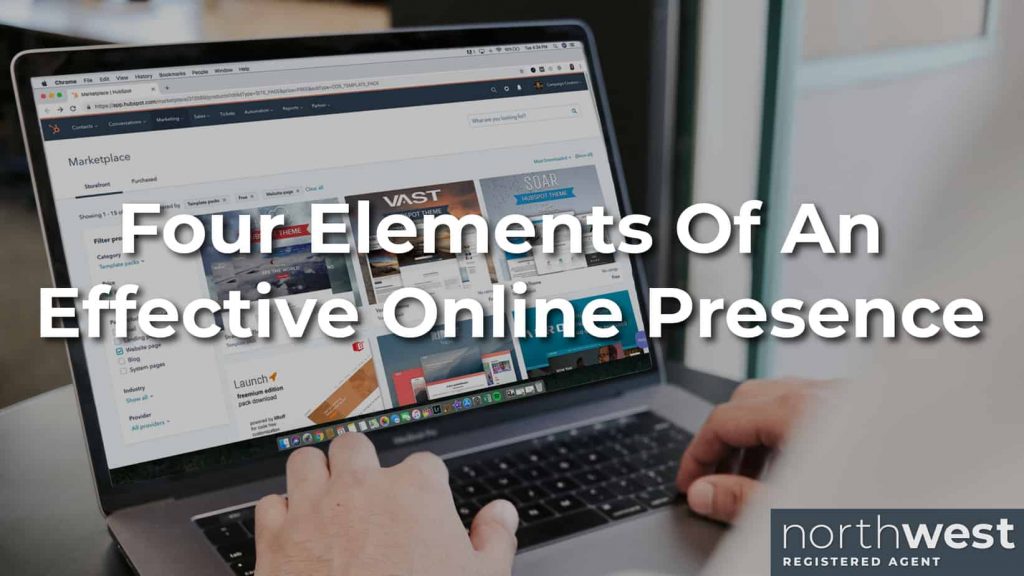Four Elements Of An Effective Online Presence

Gone are the days in which you would walk by a shop on the street, be intrigued by the window displays, and pop in on a whim. Nowadays people don’t have time to just waltz in to places, and they no longer follow their curiosity down the street like a stray cat. They’re following their phones. Consumers follow the “nearby” tagged businesses on Google as if the search results and amount of gold stars next to it are sage wisdom. As technology and the generations that grew up with it become even more woven into the fabric of our society, the best way that you can put the cat’s curiosity back into the consumer is by having an effective online presence.
Step 1: Get Yourself A Website
With companies like Squarespace and Wix, creating a website for your business has never been easier. There’s truly no reason why your company shouldn’t have, at the least, a website. The perks of having a website are infinite and not having one may be the thing that makes or breaks your company. Here are a few reasons having a website is critical to the success of your business:
Having a Website Makes You Legitimate
Imagine a time when you’ve sought out a company for a specific purpose. It’s likely that you’ve made your decision based on the amount and credibility of information available. A company with a website, a listing in a phone book, and a social media presence always appears to be more legitimate than a company with only a line in the yellow pages. Think of a website as an entire presentation. Your customers are the audience and the performance is devoted to crafting a narrative that is completely in your control. Tell them the story of your company through a congruent brand message. Most importantly, tell them the complete services you provide, and the hours that you are open to do it!
Your Competition Has A Website
If you’re trying to emerge into an established market, your competition already has a website. Even if you have been beat to the punch, you can look at establishing your own web presence as an opportunity to set yourself apart from them. Make you’re website better, fresher, more captivating.
Get Google In Your Corner
If you’re a small business owner, Google is your friend. Having a website is a huge advantage in the verification process for a Google My Business Account. Google is the premier vessel for local online exposure and making sure that your company is recognized is paramount to the success of your business. Once you have a website up and running, it’s time to move to the next step: making sure your showing up in potential customers’ web searches.
Step 2: Maximize Your Online Local Exposure
Once you have a website, you’ve opened the door to maximize the online effectiveness of your 1business. Once you have something for Google’s algorithms to hold onto, the world is your oyster. The first step is verifying your Google My Business Account (GMB). Then, get the ball rolling and establish a Yelp account and tap into any other review-based websites specific to your industry. If people are searching online for a service, they are likely to dig pretty deep. Getting your business name in as many places as possible and relevant is a good idea.
- Searchability
Once your business is verified on GMB, Google uses your business type and location in order to generate results for searches. For example, once you’ve listed your location in Google, someone could simply search “Pizza Near Me” and your business would come up if they were in your vicinity. - Side Bar
A GMB account allows for Google to populate a very useful sidebar when your business is searched for. It conveniently displays your business name, any photos you upload, phone number, address, and even links out to your website and the pinned location of your store on Google Maps. - Analytics
After you’ve had a GMB account for a while, Google indexes tons of data that’s super helpful to small business owners. You will be able to monitor how many times you’ve come up in searches, how many people have viewed your profile, and how many people have mapped to your location. - Reviews
Google also gives your customers a platform to leave you reviews for your business, which sometimes can be a real pain, but it’s a great way to receive feedback from your customers and establish some credibility and “electronic word of mouth” for your small business.
Yelp
Google isn’t the only place where people might leave snide (or maybe glowing) feedback. The most famous (or infamous) review platform is Yelp. It’s a lot like a phone book with a comments section. You don’t have to make a Yelp account, but odds are you’ll get one sooner or later. The key for small business owners is to create their Yelp profile and then actively manage these reviews as they come in. Unfortunately, everyone’s a critic and thanks to Yelp, we have to appease them a bit. The reason for this, is because like it or not, people use Yelp as a legitimate metric in the overall quality of a business’ services.
Step one in managing Yelp reviews is creating your account and then verifying it. You can then accurately list your business address, contact information, and hours of operation instead of having a random user do it for you. Another perk of actively managing your own Yelp business profile is that when you do have a review posted from a customer, you will be immediately notified and can then take action. If you receive a negative review on Yelp, the course of action you take will be highly dependent on the situation and the nature of your business. A good general rule of thumb is to not leave negative reviews ignored. Instead, acknowledge and interact with all customer feedback—especially if your business is just getting off the ground and establishing a client base.
Step 3: Use Your Online Presence Against Your Competition
Once you have an actual presence online, it’s time to put it to use. Advertising for your small business used to be an astronomic expense. The good news is that radio jingles and massive billboards have been replaced by Google rankings and digital word of mouth, and those can be maximized for free with a little know how and patience. Online advertising is a complex and competitive arena, bust rest assured that your competition is facing many of the same hurdles and obstacles that you are.
The first thing that you should do is research competing companies. Regularly monitor them and take note of what they are doing wrong in their online presence and-more importantly-what they are doing right so you can go the extra mile to set your business apart.
In addition to monitoring your competition, develop a unique online voice for your company that stands apart. While you may sell service and products that are very similar to your competition, use your brand image and online presence to exemplify why your company is better. One sure fire way to do this is via social media.
Step 4: Develop a Social Media Plan
The two most popular social media platforms are Facebook and Instagram. Developing a plan to reach customers via both is critical to competing for customers on the web. Once you’ve worked through the previous steps, devise a way to integrate your message and brand into unique and engaging social media posts. Many companies use specific social media software to monitor popular traffic times and to create a posting schedule. If you are just starting out, this may be overkill. It may be a good idea to just try a few things out and see what kind of feedback you receive. Because both of these sites reflect engagement via “likes” or “double taps,” figuring out what works and what doesn’t will be relatively
easy.
When Is The Work Done?
One thing that old fashioned advertising and this newfangled online world have in common is that the work is never done. Making sure your web content is competitive, fresh, and engaging is a job that will continue as long as your company in business. If you’re a beginner, don’t let that news be discouraging. Finding and reaching customers via the internet gets easier with time and sooner than you know it, you’ll be an online presence professional.



